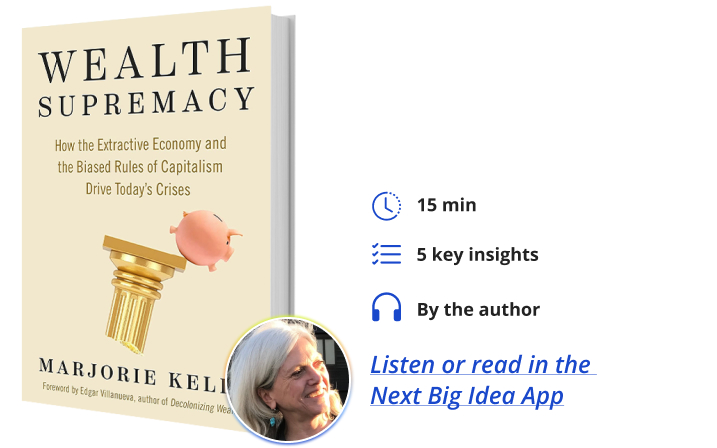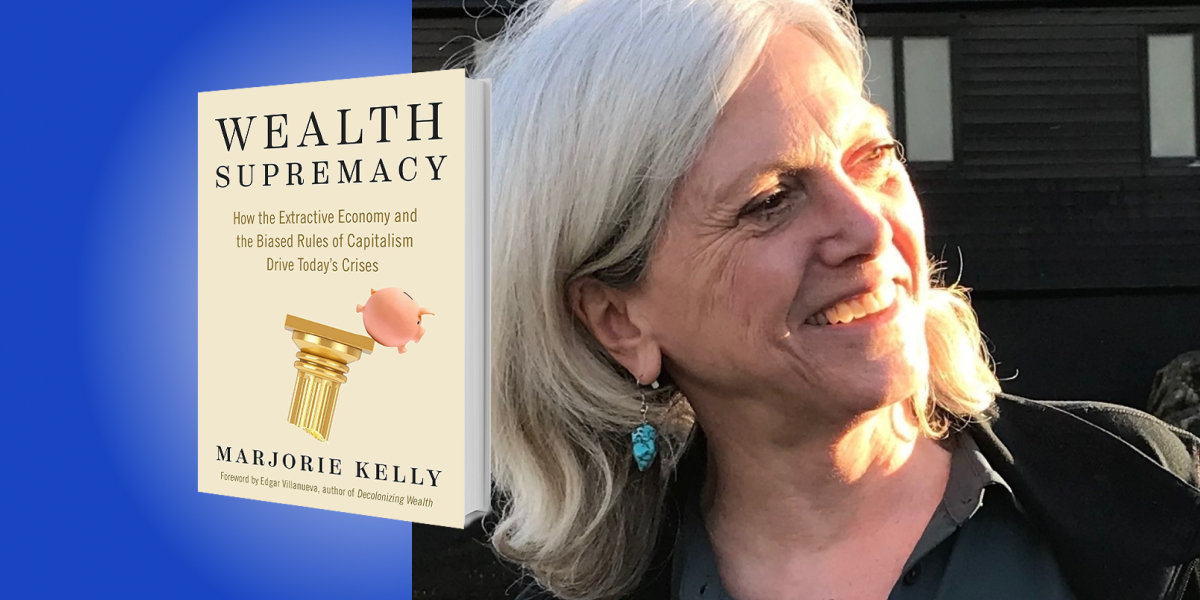Marjorie Kelly is a journalist and consultant. She is a distinguished senior fellow at The Democracy Collaborative. Her work has been featured in Fast Company, Impact Alpha, and Stanford Social Innovation Review, among other publications.
Below, Marjorie shares 5 key insights from her new book, Wealth Supremacy: How the Extractive Economy and the Biased Rules of Capitalism Drive Today’s Crises. Listen to the audio version—read by Marjorie herself—in the Next Big Idea App.

1. There’s too much financial wealth in the world.
Our culture tends to view wealth creation as benign and wonderful. This bias toward wealth makes it difficult for us to digest the warnings of economists that the world is awash in far too much financial capital, just as the atmosphere is awash in too much carbon.
It’s a problem we’re not talking about yet. Economists call it financialization. It’s the source of many crises: families mired in debt, jobs that are insecure and pay low wages, the way companies routinely fight unions, monopolies that crush family businesses, politics captured by billionaires, and our inability to tackle climate change.
So much wealth concentrated in the hands of the one percent is a sign of sickness, not health. Much of that wealth isn’t created from productive activity. It’s extracted from ordinary people and the planet. Two out of three Americans live in asset poverty—lacking $1,000 for unexpected expenses, like a car repair or a child’s illness. Forty percent of jobs are insecure, part-time, contract, Uberized gig work. Economist Dirk Bezemer told us that the finance sector “has become the locus where inequality is generated.”
It doesn’t have to be this way. In Cincinnati, we can see how the extractive economy can be stopped by investing for the public good. In 2008, after Big Capital financialized mortgages and nearly brought down the global economy, American families lost more than $7 trillion in home equity. Those foreclosed houses got snapped up by none other than Big Capital, buying one in five homes in Cincinnati. They maximized profit by neglecting maintenance, raising rents, and aggressively evicting. The City of Cincinnati stepped in to stop financialization by issuing a $16 million bond to buy 200 houses from private equity, to build local resilience. For these homes, they kept rents low, took care of maintenance, and trained renters to become homeowners. This is how a locally rooted economy with ownership in broad hands is being built. This is how we the people can build an economy for all.
2. Wealth inequality is driven by wealth supremacy.
Wealth supremacy is the idea that wealthy people matter more than the rest of us and that the aim of our economy is to create more income for the wealthy and Big Capital.
We don’t recognize financialization as a problem because we view the world through the lens of wealth supremacy, or as I call it, capital bias. Until we name bias, it remains invisible. Capital bias is embedded in seven myths of extractive capitalism. Each is fundamentally flawed and works against a democratic economy.
- The Myth of Maximizing. No amount of financial wealth is ever enough. We call this “return on investment.” It is ideally maximum, limitless, and eternal.
- The Myth of Fiduciary Duty. The most sacred duty is that owed by the managers of wealth to the owners of wealth, the duty to protect and expand capital, no matter the consequences.
- The Myth of Corporate Governance. Workers are not members of the corporation. Membership is reserved for absentee capital, while workers create the wealth that capital extracts.
- The Myth of the Income Statement. Income to capital (profit) is always to be increased, while income to labor (expense) is always to be decreased.
- The Myth of Materiality. Gains to capital are real (material), while social and ecological damages are not real (not material) except to the extent they affect capital.
- The Myth of the Free Market. Democracy is to be subdued, for it is the enemy of independence and power through wealth. There shall be no limits on the field of action of corporations and capital. We call this a “free market.”
- The Myth of Takings. The first duty of government is the protection of wealth. The U.S. Constitution prohibits “takings” from the propertied elite, while that elite may take from others at will.
3. Wall Street wants a piece of everything.
If Wall Street financialized mortgages and then houses, it’s doing the same with health care. It’s buying up elder care homes and rural hospitals, cutting staff, and reducing services. Wall Street is also doing this with newspapers, extracting every dime of profit until these papers die. Big capital wants to own the gene pool, to monetize our identities. It’s out there buying water rights. It’s setting up natural asset companies to turn the planet itself into a new asset class, monetizing “ecosystem services,” from water, forests, coral reefs, and farms.
Virtually all successful businesses end up in the grip of finance. Any business owner can extract too much profit, but when businesses are bought up by large financial firms, or go public, greed goes on autopilot. Companies are no longer profit making but begin profit maximizing. It’s like the difference between social drinking and being an alcoholic.
“Companies are no longer profit making but begin profit maximizing.”
With businesses, there’s a conveyor belt constantly functioning, which works like this: No founder lives forever. Fewer than one in three pass their business on to family. Of these, only 12 percent make it to the third generation as a family firm. Once a founder retires or dies, most small businesses close. The rest are sold—often to competitors, some to private equity. Whatever social good the founders wanted to create, it tends to get squeezed out.
I saw this happen at Smith & Hawken, a gardening supply company co-founded by Paul Hawken, author of The Ecology of Commerce. This mission-driven firm grew to have 22 stores, then the founders sold to a large investment firm, only to see their company sold over and over again, until the founders started telling their friends to stop shopping there. Its ecological mission was gone. Today, Smith & Hawken is just a brand at Target.
4. The democratic economy is growing all around us.
One great example is Gardener’s Supply. This is a firm that has kept its ecological mission alive. It’s 100 percent owned by workers, and it’s a B Corp, which means ecological and social mission is embedded in the way the firm is governed.
This is business as a force for good. Gardener’s Supply located itself next to the Intervale, a 700-acre floodplain that had become a dumping ground, and they cleaned it up, pulling 1,000 tires and 350 abandoned cars out of it. It’s now a rich agricultural zone where young farmers are given help to get a start, and people come from around the world to visit this crown jewel of the local food movement.
Gardener’s Supply shows us an alternative to the conveyor belt feeding all firms into the maw of Big Capital. Through broad-based ownership and embedded public purpose, this company has become a living system—designed to benefit the larger living system of the earth. All companies would look like this in a democratic economy.
Also, all investing should have social and ecological benefits baked in. We need land, housing, water, and electricity services to be broadly and locally owned in the public interest—like the 15 percent of forests now controlled by Indigenous and community groups worldwide, in a model the UN calls vital for protecting endangered species. Or like the 85 percent of Americans who get their water from municipally-owned utilities; evidence says they’re getting better service at a lower cost than through privatized water.
The models we need are here, and policy can scale them up. Such as the community wealth-building approach to local economic development, now being practiced in places like Chicago, Amsterdam, and the entire nation of Scotland. There are models of economic development where communities transform by having ownership and control of their own assets.
5. GDP doesn’t tell us what’s really going on.
The figure of GDP is almost quaint in today’s financialized economy. It’s like using a rotary phone in the era of the cell phone. New kinds of national reporting are needed.
GDP represents the real economy, the world of jobs and purchasing, all the flows of income and spending. Sitting atop this real economy is the sphere of finance, meaning the combined total of all financial assets, like stocks, bonds, business equity, and other kinds of debt. This financial sphere (in the U.S.) is now five times the size of the real economy. Financial assets dwarf GDP. Massive as they are, the operating system of our economy says those financial assets need to keep growing. That’s the first myth—that no amount of wealth is ever enough.
“Fully one-third of all the income sloshing around is being vacuumed up by financial firms and their clients.”
In our financialized world, one way that finance grows is by extracting wealth from the rest of us. At TDC, we commissioned research by economists, who looked at the UK (an economy very similar to the U.S.) and found that more and more of GDP is being siphoned off by finance. In 1970, finance took 13 percent of GDP. Today, it’s taking 33 percent. Fully one-third of all the income sloshing around is being vacuumed up by financial firms and their clients. So, when it seems like GDP is growing, it’s not reaching the rest of us. Much of finance is not creating wealth but skimming off wealth.
To begin to understand what’s going on, we need new kinds of national reporting, like metrics showing the difference between financial sector GDP and real economy GDP.
To move beyond a world of wealth supremacy and to dismantle financialization, we need to name what’s going on, see it, and measure it. If we are to break the cycle, we need solutions that both stop financial extraction and build a democratic economy based on recirculating wealth, keeping it in broad hands, locally rooted, creating stability and broad prosperity for the majority.
To listen to the audio version read by author Marjorie Kelly, download the Next Big Idea App today:































